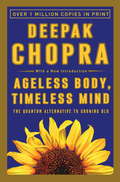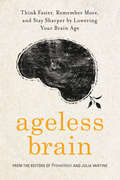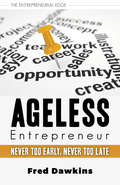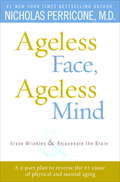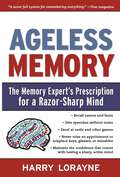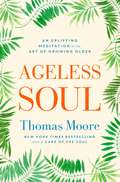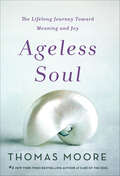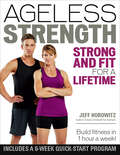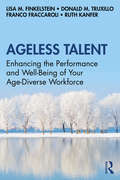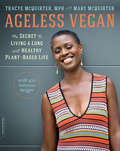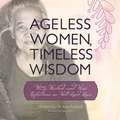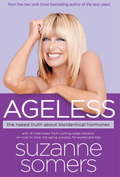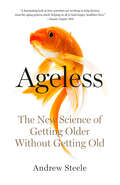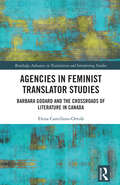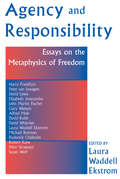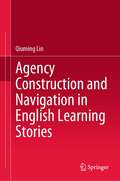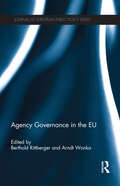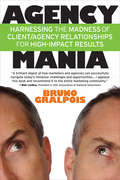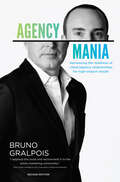- Table View
- List View
Ageless Body, Timeless Mind
by Deepak ChopraAgeless Body, Timeless Mind goes beyond current anti-aging research and ancient mind/body wisdom to dramatically demonstrate that we do not have to grow old! Dr. Chopra shows us that, contrary to traditional beliefs, we can learn to direct the way our bodies and minds metabolize time and actually reverse the aging process -- thereby retaining vitality, creativity, memory, and self-esteem. In a unique program that includes stress reduction, dietary changes, and exercise, Dr. Chopra offers a step-by-step, individually tailored regimen for maximum living in exceptionally good health. For the young at heart, here is the most remarkable approach yet to achieving unbound physical and spiritual potential.From the Trade Paperback edition.
Ageless Body, Timeless Mind
by Deepak ChopraAgeless Body, Timeless Mind goes beyond current anti-aging research and ancient mind/body wisdom to dramatically demonstrate that we do not have to grow old! Dr. Chopra shows us that, contrary to traditional beliefs, we can learn to direct the way our bodies and minds metabolize time and actually reverse the aging process -- thereby retaining vitality, creativity, memory, and self-esteem. In a unique program that includes stress reduction, dietary changes, and exercise, Dr. Chopra offers a step-by-step, individually tailored regimen for maximum living in exceptionally good health. For the young at heart, here is the most remarkable approach yet to achieving unbound physical and spiritual potential.From the Trade Paperback edition.
Ageless Body, Timeless Mind: The Quantum Alternative to Growing Old
by Deepak ChopraThere is nothing inevitable about aging--that is the inspiring message from Dr. Deepak Chopra. "Once again Dr. Chopra presents us with information that can help us live long, healthy lives. For all those interested in a long, full life, this book is a valuable resource. "--Bernie Siegel, M. D. , author of Love, Medicine and Miracles. Over 1. 5 million copies sold. National bestseller. Line drawings.
Ageless Brain: Think Faster, Remember More, and Stay Sharper by Lowering Your Brain Age
by The Editors of Prevention Julia VanTineBreakthrough research has revealed that through living a brain-healthy lifestyle, we can reduce our “brain age” to improve memory, hone sharpness, and reduce health risks as we age.It’s normal for the brain to short-circuit every now and then—you put your keys in the fridge, or can’t find the pair of glasses on top of your head. But what if there was a way to eat, exercise, and live that could eliminate these “senior moments?” Ageless Brain offers a plan to sharpen your memories and mind so that at 40, you have the quick, agile brain you had at 30. Based on groundbreaking scientific research, this plan is filled with brain-healthy foods, exercises, and little ways you can positively impact your most vital organ every day by de-stressing, adjusting your attitude, and constantly interacting with the world through play.Scientists have discovered that the human brain continually generates new neurons—forging new pathways and connections in our minds—well into old age, as long as we pursue brain-healthy lifestyles from what we eat and how much we sleep, to how we exercise and handle stress. Exercising and nourishing our brains just like we do any other ailing organ encourages this growth—improving not only our mental fitness but also our physical fitness as a side effect.With Ageless Brain, you will:· Discover the 10 Commandments of an ageless brain· Reduce key risk-factors for Alzheimer’s· Identify and avoid brain poisons lurking in food, medicines, and home· Learn to play and engage your brain more in everyday life· Drop unsafe levels of blood pressure, cholesterol, and sugar—as well as belly fat· Keep your brain nourished with 45 recipes
Ageless Entrepreneur: Never Too Early, Never Too Late
by Fred DawkinsAgeless Entrepreneur offers a new perspective on the barriers to entry that young people face today in starting their careers as well as valuable insights into the possibilities for seniors, who all too often are being forced out of the work force when they can least afford it. Entrepreneurial guru Sam Macleod leads an improbable group of would be entrepreneurs into new challenges and unexpected alliances that revitalize their future. Spearheading the group is Sam’s boyhood friend Nick, who like so many others has received the golden handshake prematurely. Throughout the narrative, the qualities required of an entrepreneur operating in an economy burdened with barriers and limitations are brought out through discussion and a wide range of anecdotes. The story draws us right into the class as we share in the fears, hopes, and challenges faced by the characters. The lessons provide a solid foundation for anyone considering a career as an entrepreneur or simply looking to make sound strategic decisions in managing their career, no matter what their age or circumstance.
Ageless Face, Ageless Mind: Erase Wrinkles and Rejuvenate the Brain
by Nicholas Perricone MDIn this revolutionary book, bestselling author and anti-aging expert Dr. Nicholas Perricone reveals a completely new and hidden threat to our looks and our health–and gives us a program to defeat it.Dr. Nicholas Perricone has gotten to the bottom of accelerated aging with the discovery of AGEs (Advanced Glycation End Products). AGEs are at least as detrimental to our health as transfats but have been largely unknown outside the medical community. AGEs give us wrinkles, but they have also been implicated in serious age-related conditions that cut across all medical specialties, from Alzheimer’s and cataracts to cardiovascular disease, diabetes, and cancer. Yet we have not had strategic interventions for stopping and reversing the effects of AGEs until now. Dr. Perricone shows us how to win the fight against AGEs with a three-part plan of attack that includes a nutritional program, targeted supplements, and new topicals. His groundbreaking program helps to • erase wrinkles and firm sagging skin • reverse age-related memory loss• heal cardiovascular disease• stop precursors of cancer• prevent symptoms of diabetesAgeless Face, Ageless Mind brings us not only a new and exciting field of research and its remarkable discoveries, but also a way to fight one of the biggest hidden threats to our immediate and long-term health.
Ageless Memory: The Memory Expert's Prescription for a Razor-Sharp Mind
by Harry LorayneThe world's foremost memory expert?and mega-bestselling author?proves that memory CAN get better with age! Diet and exercise are great, but what good is a healthy body if you don't have the mental capabilities to go with it? Harry Lorayne, who is now 83 years old, has been honing and teaching his foolproof system for sharpening the mind, improving concentration, and attaining a truly "superpower" memory for more than 40 years. Ageless Memory is the culmination of this memory expert's life's work. Specifically geared to our needs as we age, his unique memory system can be put into practice immediately?for a better memory the very same day you open the book and start to read! Completely practical and easy to use, readers learn to:Recall names and faces, even years laterNever miss an appointment or misplace keys, glasses, valuables, etc. Give speeches without notes and learn foreign words and phrases easily Memorize long lists of items, quotations, long numbers, Bible verses, and all kinds of facts and figures Excel at cards and other games Regain (or maintain!) the confidence that comes with having a sharp, active mind.It's not necessary to accept poor or waning memory or "senior moments" as inevitable results of growing older? and Harry Lorayne proves it in Ageless Memory!
Ageless Nation: The Quest for Superlongevity and Physical Perfection
by Michael G. ZeyIn this intriguing volume, futurist and author Michael G. Zey imagines a time in which technology has stretched human life spans to four hundred years or more. Genetic engineering, cloning, and stem-cell technology will eradicate diseases and allow for nanoscopic repair and maintenance of the body. "Smart drugs" and caloric restriction programs will largely stop aging and ensure healthy bodies and sharp minds indefinitely.Grounding his speculation in contemporary scientific research, Zey's optimistic vision sees retirement replaced by hiatuses between careers, and leisure time spent in multi-generational homes. Key players in the debate include supporters like Cambridge University scientist Aubrey de Grey, who envisions five-thousand-year life spans, and the radical futurist author Ray Kurzweil, who foresees the merging of humans and computers. Organizations such as the Coalition to Extend Life lobby the government for immortality research funding and find opposition in the President's Council on Bioethics and "deep ecologists" advocating zero-population growth.Criticizing current environmental trends as anti-progress and anti-human, Zey's own solutions include controversial measures like human control of weather, colonization of outer space, and genetically modifying food. He concludes that the eventuality of a modern Fountain of Youth is closer than we think. Zey's predictions about the future are thoughtful and fascinating.
Ageless Soul: An uplifting meditation on the art of growing older
by Thomas MooreFROM THE NEW YORK TIMES BESTSELLING AUTHOR OF CARE OF THE SOUL COMES AN UPLIFTING MEDITATION ON THE ART OF GROWING OLDER ‘Thomas Moore convinces us that we age best when we embrace our age, live agelessly, and remember every day to find the endless joy nestled inside our soul’Dr Rudolph E. Tanzi, Professor of Neurology, Harvard Medical School, and New York Times bestselling author of Super Brain and Super Genes Ageless Soul reveals a fresh, optimistic and rewarding path towards ageing. Renowned psychotherapist and bestselling author Thomas Moore shows us that as we grow older we become more distinctive and complex. Drawing on stories from his practice as a psychotherapist and teacher, Moore argues for a new vision of ageing and shows readers how to embrace the richness of the experience and how to feel fulfilled as they grow older. Thomas Moore is the New York Times bestselling author of Care of the Soul,as well as many other books on enriching your life. At turns he has been a monk, a musician, a university professor, and a psychotherapist. Today he lectures widely on creating a more soulful world and on spirituality. ‘With Ageless Soul, Thomas Moore extends a magnificent invitation to reflect, grow up with joy and intention, and give back with an open heart. Accept and pleasure follows.’Marc Freedman, founder and CEO of Encore.org and author of The Big Shift
Ageless Soul: The Lifelong Journey Toward Meaning and Joy
by Thomas MooreAgeless Soul will teach readers how to embrace the richness of experience and how to take life on, accept invitations to new vitality, and feel fulfilled as they get older.Thomas Moore is the renowned author of Care of the Soul, the classic #1 New York Times bestseller. In Ageless Soul, Moore reveals a fresh, optimistic, and rewarding path toward aging, one that need not be feared, but rather embraced and cherished. In Moore’s view, aging is the process by which one becomes a more distinctive, complex, fulfilled, loving, and connected person. Using examples from his practice as a psychotherapist and teacher who lectures widely on the soul of medicine and spirituality, Moore argues for a new vision of aging: as a dramatic series of initiations, rather than a diminishing experience, one that each of us has the tools—experience, maturity, fulfillment—to live out. Subjects include:*Why melancholy is a natural part of aging, and how to accept it, rather than confuse it with depression *The vital role of the elder and mentor in the lives of younger people*The many paths of spiritual growth and learning that open later in life*Sex and sensuality *Building new communities and leaving a legacy
Ageless Strength: Strong and Fit for a Lifetime
by Jeff HorowitzAgeless Strength shows athletes and active people how to build sustainable fitness for a lifetime of active pursuits. It’s a myth that our older years only bring physical decline. While it’s true that we lose strength, bone density, and balance, our bodies react the same way to training at any age. The answer is not to go easy on our so-called fragile bodiesthat traditional approach of gentle, easy fitness just guarantees loss. The key is to push our bodies in the right ways. A smart mix of strength training can counteract the physical effects of agingand keep you strong and fit for years. With the program in Ageless Strength, you can get into the best shape of your life at any age. In his proven program, coach and trainer Jeff Horowitz reveals exercises that fight back against the years. His dynamic and engaging mix of 50 simple strength exercises will build strength, bone, and balancecombating the top three physical changes that lead to injury and loss of strength. These effective exercises use bodyweight or minimal equipment so that no gym membership is required. Each functional strength move mimics a real-life motion so you’ll know it will help your day-to-day fitness. The 6-week quick-start program will get you up to speed, then you can follow the long-term strength program or select from the color-coded exercises to design your own. In just two 30-minute sessions a week, Ageless Strength offers a simple, effective way to get strong and fit for a lifetime of active pursuits.
Ageless Talent: Enhancing the Performance and Well-Being of Your Age-Diverse Workforce
by Lisa M. Finkelstein Franco Fraccaroli Donald M. Truxillo Ruth KanferAgeless Talent: Enhancing the Performance and Well-Being of Your Age-Diverse Workforce provides organizational leaders, managers, and supervisors with clear, evidence-based tactics by which to develop and manage an aging and age-diverse talent pool. This volume provides an easy-to-implement set of tools for addressing the difficult problems related to employee performance and well-being amid ongoing technological and social change. Ageless Talent introduces a straightforward framework (PIERA) that translates scientific advances into actionable steps and strategies. Using this framework, this book provides practical illustrations to help readers design their own small-scale interventions to achieve desirable goals under diverse organizational constraints. Furthermore, the book addresses modern management challenges arising across the globe, and offers suggestions for leaders interested in short-term and long-term change. These suggestions, grounded in time-tested and leading-edge research evidence, include specific step-by-step guidelines, customizable to different types of organizations and industries. With economic, cultural, technological, and demographic shifts making the changing nature of work a pressing concern for organizations around the globe, Ageless Talent is an essential text for practitioners – HR professionals, organizational leaders, and managers – as well as management education programs and professional training and leadership programs. It will also appeal to instructors and students in the field of industrial/organizational psychology.
Ageless Vegan: The Secret to Living a Long and Healthy Plant-Based Life
by Tracye McQuirter Mary McQuirterHarness the healing power of plant-based foods for vibrant health and longevityVegan lifestyle expert Tracye McQuirter teams up with her mother Mary to share their secrets for maintaining radiant health for more than 30 years (hint: it's all in the greens), and 100 of their favorite plant-based recipes that have kept them looking and feeling ageless. They break down the basics of nutrition, how to build a vegan pantry, and how to make sure you're getting the best nutrients to promote longevity and prevent chronic disease. They also provide a 14-step guide with practical, easy-to-follow advice on how to transition to vegan foods, jumpstart your healthy eating habits, and how to up your game if you're already a vegan. Their 100 fresh, simple, and flavorful recipes are based on everyday whole food ingredients, including Maple French Toast with Strawberries, Thai Coconut Curry Soup, Cajun Quinoa with Okra and Tomato, Vegetable Pot Pie, Citrusy Dandelion Greens Salad, and Perfect Pecan Pie. Illustrated with beautiful, full-color photographs, Ageless Vegan helps you kiss diet-related disease and fatigue goodbye and gives you the information, inspiration, and affirmation you need to live a long, glowing, and healthy life you love.
Ageless Women, Timeless Wisdom: Witty, Wicked, and Wise Reflections on Well-Lived Lives
by Dr Lois Frankel Lisa GravesFrom New York Times–bestselling author: “A book to share with every woman in your family” honoring the wisdom and spirit of older women (Evelyn Champagne King). These women have lived decades raising children, caring for husbands, and creating nests out of which children fly to be productive members of society. Often being forced to observe more than participate in the events around them, they have unique insights that can help future generations not merely survive, but thrive. In Ageless Women, Timeless Wisdom, Dr. Lois Frankel gives center stage to these wise women. From Los Angeles, California, to Shanghai, China, women aged seventy and older share thoughts and stories that are heartwarming and hilarious; insightful and witty; philosophical and practical: “When life gives you lemons,” says Jo-Ann Mercurio, born in 1941, “add vodka.” This book, with lovely illustrations by Lisa Graves, is an important record of women’s reflections on lives well lived. It is sure to be passed from grandmother to daughter to granddaughter. “I love this book! Wisdom and wit worth remembering and sharing.” —Josh Berman, creator and executive producer, Drop Dead Diva and CSI “It would be a shame if the humor and inspiration from these wise women was lost. Dr. Lois captured their spirits . . . This is truly a good read.” —Evelyn Champagne King “It’s about time for a book like this. For too long the wisdom of older women has gone unnoticed, unappreciated, and undervalued . . . Sure to put a smile on your face and the faces of the women you share it with.” —Rita Coolidge
Ageless: The Naked Truth About Bioidentical Hormones
by Suzanne SomersCan you really feel better as you get older?Is aging without illness possible?Is your own internal fountain of youth waiting to be discovered?Yes, yes, and YES! says Suzanne Somers, the bestselling author of The Sexy Years. It can all be true when you take advantage of the new science of antiaging medicine--a revolutionary approach to achieving the ageless life.Suzanne Somers introduced millions of women to bioidentical hormone replacement therapy and changed the way we look at menopause with her groundbreaking book, The Sexy Years, and the overwhelming media response to its publication. Now, in Ageless, Suzanne introduces an inspiring, medically validated approach to reversing the aging process and maintaining a healthy, vibrant, mentally sharp, sexually active life--while building the body's natural defenses against age-related diseases.Ageless is jam-packed with new, updated information on bioidentical hormone replacement and antiaging that will change your life forever. Suzanne talks about:* Antiaging medicine and how it can help work against the environmental assault that is making us sick, including how to detox the body of harmful pollutants and chemicals and strengthen our weakest glands and organs* Menopause, which can become an enjoyable passage once the body is in perfect hormonal sync with bioidentical hormone replacement therapy* The dangers of perimenopause and how women can treat it* Why so many hysterectomies are unnecessary, how birth control pills may have contributed to the rise of hysterectomies, and how to restore your body to perfect hormonal balance after having one* How andropause is a real condition for men, and how men can lose weight, regain their youthful physiques, and restore heath, energy, and sexuality, all through bioidentical HRT* The importance of sleep and the healing work that nature does during this time to balance hormones and increase energyIn this "antiaging bible," Suzanne brings together prominent, Western-trained antiaging doctors who are at the forefront of a medical revolution to show how the traditional medical approach is woefully inadequate and outdated. Its standard of care has been to treat all symptoms with drugs, but in Ageless you will find out how this approach does not make us better. With antiaging medicine you can heal your body rather than keep a chronic condition at bay with drugs. Ageless shows you how to keep your "insides" young, and how this manifests on the outside.What could be better than having your doctor tell you that you have the bones of a twenty-year-old, or the heart of a thirty-year-old? You can be young on the inside if you follow the advice in Ageless. Suzanne reveals the secrets to youthfulness that everyone can achieve and shows us all how to live the ageless life!How young is your energy?"The second half of your life can be better than your first half. A better life, a healthier life, a life of youthful energy comes from embracing antiaging medicine, and bioidentical hormone replacement is a big component. . . . The second half of life can be wonderful. I know it because I am living it. This new approach to health gives you back your lean body, shining hair, and thick skin, provided you are eating correctly and exercising in moderation. This new medicine allows your brain to work perfectly and offers the greatest defense against cancer, heart attack, and Alzheimer's disease. Don't you want that?" --From the IntroductionAlso available as a Random House Large Print EditionFrom the Hardcover edition.
Ageless: The New Science of Getting Older Without Getting Old
by Andrew SteeleA startling chronicle by a brilliant young scientist takes us onto the frontiers of the science of aging, and reveals how close we are to an astonishing extension of our life spans and a vastly improved quality of life in our later years.Aging--not cancer, not heart disease--is the true underlying cause of most human death and suffering. We accept as inevitable that as we advance in years our bodies and minds begin to deteriorate and that we are ever more likely to be felled by dementia or disease. But we never really ask--is aging necessary? Biologists, on the other hand, have been investigating that question for years. After all, there are tortoises and salamanders whose risk of dying is the same no matter how old they are. With the help of science, could humans find a way to become old without getting frail, a phenomenon known as "biological immortality"?In Ageless, Andrew Steele, a computational biologist and science writer, takes us on a journey through the laboratories where scientists are studying every bodily system that declines with age--DNA, mitochondria, stem cells, our immune systems--and developing therapies to reverse the trend. With bell-clear writing and intellectual passion, Steele shines a spotlight on a little-known revolution already underway.
Agencies in European Banking: A Critical Perspective (Palgrave Macmillan Studies in Banking and Financial Institutions)
by Marta Božina BerošThis book studies relationship dynamics between National Competent Authorities (NCAs) within two agencies governing the European banking sector: the European Banking Authority and the Single Resolution Board. The analysis centres on NCAs policy preferences and the variety thereof, particularly in the context of banking market fragmentation (Euro area vs. non-Euro area countries/banking union "ins" and "outs"). The focus is not so much on the motivations of these preferences, but on the processes and mechanisms that help reach NCAs consensus on prudential matters. Through an interdisciplinary approach rooted in legal analysis and political economy, the book shows how national actors inform decision-making within European agencies in banking, and whether—and how—the reality of differentiated integration within the internal banking market challenges policy creation.
Agencies in Feminist Translator Studies: Barbara Godard and the Crossroads of Literature in Canada (ISSN)
by Elena Castellano-OrtolàThis book sets out a new framework for a feminist history of translators, drawing on the legacy of Canadian scholar Barbara Godard and her work in establishing the Canadian literary landscape as a means of exploring agency in feminist translation studies and its implications for cross-disciplinary debates.The volume is organised in three sections, establishing feminist translator studies as its own approach, examining these dynamics at work in a comprehensive portrait of Barbara Godard’s scholarly and literary history, and looking ahead to future directions. In situating the discussion on Godard and Canadian literary history, Elena Castellano calls attention to a geographic context in which translation and its practice has been at the heart of debates around national identity and intersected with the rise of feminism and feminist literary scholarship. The book demonstrates how an in-depth exploration of the agency of an individual stakeholder, whose activities spanned diverse communities and oft conflicting interests, can engage in key questions at the intersection of nation-making, translation, and feminism, paving the way for future research and the further development of feminist translator studies as methodological framework.This book will be of interest to scholars in translation studies, feminist literature, cultural history, and Canadian literature.
Agency And Responsiblity: Essays On The Metaphysics Of Freedom
by Laura EkstromA companion volume to Free Will: A Philosophical Study, this new anthology collects influential essays on free will, including both well-known contemporary classics and exciting recent work. Agency and Responsibility: Essays on the Metaphysics of Freedom is divided into three parts. The essays in the first section address metaphysical issues concerning free will and causal determinism. The second section groups papers presenting a positive account of the nature of free action, including competing compatibilist and incompatibilist analyses. The third section concerns free will and moral responsibility, including theories of moral responsibility and the challenge to an alternative possibilities condition posed by Frankurt-type scenarios. Distinguished by its balance and consistently high quality, the volume presents papers selected for their significance, innovation, and clarity of expression. Contributors include Harry Frankfurt, Peter van Inwagen, David Lewis, Elizabeth Anscombe, John Martin Fischer, Michael Bratman, Roderick Chisholm, Robert Kane, Peter Strawson, and Susan Wolf. The anthology serves as an up-to-date resource for scholars as well as a useful text for courses in ethics, philosophy of religion, or metaphysics. In addition, paired with Free Will: A Philosophical Study, it would form an excellent upper-level undergraduate or graduate-level course in free will, responsibility, motivation, or action theory.
Agency Construction and Navigation in English Learning Stories
by Qiuming LinThis book presents a longitudinal research which covers a linguistic approach to understand and observe language learner agency. It makes connections between agency in discourse analyses and agency in applied linguistics by examining how learner agency is manifested in autobiographic oral narratives and influenced by contextual factors. This book also demonstrates that agency is not a fixed entity that English learners possess, but a dynamic construct constantly negotiated by the learners with the social world. It is the result of their identity positioning and repositioning within a complex and ever-changing context. Learner identities, either actual or imagined, are significantly correlated with their investment in English and their English learning process.This book sheds new light on teaching English as a foreign language and gives inspirations for enhancing English learners’ agency in contemporary context of China. As learner agency should be treated in a dynamic and process view, a low level of agency manifested in a particular period or in a certain context may not necessarily persist in later periods or extend to other contexts. Provided with supportive contextual conditions and taking on positive and powerful identities, language learners are well on the course for higher levels of agency.
Agency Governance in the EU (ISSN)
by Berthold Rittberger and Arndt WonkaThe rapid proliferation of EU agencies represents one of the most significant changes to the EU’s organisational set-up in past decades. At the same time, this development has significantly affected regulatory policy-making in the EU.This volume assembles the most renowned scholars in the field to address the key themes and challenges that agency governance in the EU poses to effective and legitimate policy-making. The first theme addresses the causes and dynamics of the creation and design of regulatory bodies in EU governance, focusing not only on EU agencies but also on alternatives to the agency format, such as regulatory networks. Second, once agencies are established, the book goes on to explore the consequences and trajectories of agency governance. How effective and autonomous are EU agencies? How does EU agency governance transform existing patterns of executive governance in the EU? Third, the book addresses the design of EU agencies as independent, non-majoritarian institutions poses pressing questions with a view to their legitimacy and accountability.The volume appeals to scholars and practitioners interested in the development and transformation of executive governance in the EU.This book was published as a special issue of the Journal of European Public Policy.
Agency Implementation of Alternative Contracting Methods
by Transportation Research Board National Academies of Sciences, Engineering, and Medicine National Cooperative Highway Research Program Mounir El AsmarThe use of alternative contracting methods (ACMs) has accelerated the delivery of highway design and construction projects. Led by documented successes on large, high-profile projects such as I-15 in Utah, the Intercounty Connector in Maryland, and the Sellwood Bridge in Oregon, ACMs have resulted in shorter project delivery times with less disruption to the traveling public. The use of ACMs is becoming commonplace in projects by state departments of transportation, but not just for large projects. The information in this document builds on the three-volume NCHRP Research Report 939: Guidebooks for Post-Award Contract Administration for Highway Projects Delivered Using Alternative Contracting Methods. NCHRP Web-Only Document 421: Agency Implementation of Alternative Contracting Methods, from TRB's National Cooperative Highway Research Program, aims to ensure agencies have the practical methods and tools to improve their ACM contract administration.
Agency Mania: Harness The Madness of Client/Agency Relationships for High-Impact Results
by Bruno Gralpois Bob LiodiceAgency Mania was written because billions of dollars in company budgets are invested every year into marketing efforts that strive to deliver engaging consumer experiences and deliver measurable business results. To get most out of their marketing investment, brand advertisers of all sizes must demand more from their advertising and marketing communications agencies, and get the best possible work from these relationships while simultaneously driving the dual agenda of effectiveness and efficiency. Why do some client/agency partnerships thrive while others fail? And how can both parties improve the chances of success? Agency Mania is an indispensable guide in which, Bruno Gralpois reveals the anatomy of a strong partnership with an advertising, media, digital, PR or marketing communications agency that drives results and delivers real value to the client's business. Mr. Gralpois shines a bright light on the insanity of clients and agencies failing to effectively nurture their relations.
Agency Mania: Harnessing The Madness Of Client/agency Relationships For High-impact Results
by Bruno GralpoisWhy do some client/agency relationships thrive while others fail? At a time of unprecedented change and complexity in marketing and advertising, Agency Mania will transform the way you look at client/agency relationships and invite you to build sustained partnerships that deliver unmatched work and results. The world of marketing is a trillion-dollar industry and is changing at a drastic pace. The advertiser/agency relationship is under incredible pressure. Some may argue it’s even broken. The future of the advertising industry is uncertain. The entire marketing ecosystem is being tested. What will the agency of tomorrow look like? What competencies will agencies need to build? How will they deliver greater value to their clients? Similarly, how will advertisers reap the benefits agencies bring to their table? How will they become better clients? How will they set their partnerships up for success? In Agency Mania, partnership guru Bruno Gralpois demonstrates that these partnerships, once managed professionally, have remarkable transformational value and measurable business impact. The author shines a bright light on the insanity of advertisers and agencies failing to work optimally together or hold each other truly accountable. Building a successful long-term advertiser/agency partnership requires a robust set of competencies and operating principles.Agency Mania shows you step-by-step how it is done.
Agency Theory and Executive Pay: The Remuneration Committee's Dilemma
by Alexander PepperThis new book examines the relationship between agency theory and executive pay. It argues that while Jensen and Meckling (1976) were right in their analysis of the agency problem in public corporations they were wrong about the proposed solutions. Drawing on ideas from economics, psychology, sociology and the philosophy of science, the author explains how standard agency theory has contributed to the problem of executive pay rather than solved it. The book explores why companies should be regarded as real entities not legal fictions, how executive pay in public corporations can be conceptualised as a collective action problem and how behavioral science can help in the design of optimal incentive arrangements. An insightful and revolutionary read for those researching corporate governance, HRM and organisation theory, this useful book offers potential solutions to some of the problems with executive pay and the standard model of agency.
